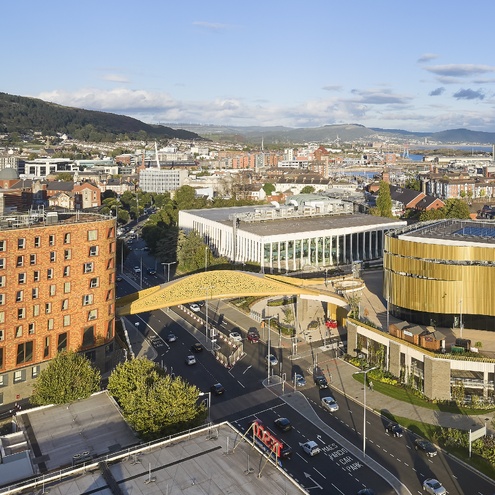Project showcase
Copr Bay Bridge, Swansea – City and County of Swansea with ACME

To connect Swansea back to the beach, a new pedestrian and cyclist footbridge now spans across Oystermouth Road, seamlessly connecting the city centre with the first phase of Copr Bay - including Swansea Arena and a Coastal Park - and the city’s maritime quarter and seafront. The 49m bridge spans six lanes of traffic.
Who is on the project team?
Project Team:
Architect: ACME
Structural Engineer: Ney & Partners
Planning Consultant: Savills
Artist: Marc Rees
Development Manager: RivingtonHark
Project Manager: Padstone
Main Contractor: Buckingham Group
Specialist Contractor: S H Structures.
Describe the context of this project and its neighbourhood and people?
Swansea is a coastal city in Wales with an illustrious industrial past, and a century as the world capital of copper production. The historic centre is only minutes from the glorious beaches of Swansea Bay, but the construction of vast docks in Victorian times, inner city main roads, industrial sheds, supermarkets and surface car parks structure have contributed to a city centre that feels far removed from the sea.
To connect Swansea back to the beach, a new pedestrian and cyclist footbridge now spans across Oystermouth Road, seamlessly connecting the city centre with the first phase of Copr Bay - including Swansea Arena and a Coastal Park - and the city’s maritime quarter and seafront. The 49m bridge spans six lanes of traffic and provides a safe, continuous connection between the different parts of Copr Bay. Importantly, the Bridge reconnects the city centre to one of Swansea’s greatest assets - its world-renowned coastline.
Copr Bay Phase One forms part of a wider transformation underway across Swansea. The £135m first phase of Copr Bay, developed by Swansea Council, has reactivated a previously underutilised plot of land by delivering a state-of-the-art, 3,500 capacity new arena – a state-of-the-art live performance area and conference centre as well as new public realm including the city’s first new coastal park since Victorian times, high-quality, new social housing and retail space for local businesses.
Describe the infrastructure project including its purpose and motivation. How does it contribute to the wider place and the community it serves?
The Copr Bay bridge provides a new gateway for Swansea - it is a celebration of the city’s past, present and future.
Part of the wider £1bn+ urban regeneration programme in the city, it is completely transforming Swansea’s built environment, encouraging new investment into the city and serving as a major catalyst for positive change for local people.
The bridge was designed as an innovative stressed skin bridge, with an impossibly thin steel deck held aloft by perforated arched steel plates. The bridge colour and lighting are designed to move in synchronisation with the illuminating facade of the Arena to create a Copr Bay district that pulsates with life at day and at night.
The bridge structure offers a degree of protection from the elements. In order to keep the bridge as thin as possible, the structure is designed as a stressed skin, made from a continuous 18mm thick steel plate. The steel has been rolled into a double curved surface and butt-welded into a single tube. Openings have been cut into the sides where the structural stresses were lower, to provide views out and to allow the bridge to glow at night from within. Swansea-born artist Marc Rees designed the pattern on the bridge’s sides featuring 2,756 laser-cut origami shapes. The performations are abstracted and exploded silhouettes of swan inspired by the emblematic Swansea bird.
In acknowledgement of Copr Bay’s history as the centre of coal and copper production, the bridge has the colour of freshly smelted copper.
Has your initiative improved connectivity to places where people live, work, play or learn?
Oystermouth Road, one of the busiest vehicular routes in Wales, has separated Swansea city centre from Swansea Bay for half a century. Swansea bridge provides a safe, enjoyable crossing and finally re-links the city centre with Copr Bay and the marina, and becomes a stepping-stone to the beach.
The bridge provides a seamless link for both pedestrians and cyclists travelling from the city centre to the new Copr Bay district and waterfront. Importantly it provides Swansea citizens easier access to nature and new play space for all ages.
Copr Bay is now the home to Swansea Arena; a 1.1. acre coastal park; and in the future residential, offices and retail and leisure uses.
“Swansea’s newest crossing, part of this ambitious reimagining of what a post-pandemic city should look like, takes this one step further in connecting the urban to nature, the hustle and bustle of the city to the sweeping coastline, and bringing with it the economic and social benefits that come from a more beautiful place to live, work, study and visit.”
Mark Williams, Executive Director of RivingtonHark
Please share any data or figures that support your entry for how this project contributed to the economic, environmental and social wellbeing of this place and its community?
• Swansea bridge forms part of the £135m Copr Bay phase one scheme that will inject an additional £17.1m into the city’s economy annually.
• The 49-metre bridge spans six lanes of traffic, acting as a gateway to the city-centre for both pedestrians and cyclists.
Festival of Pineapples
24-26 February 2026
Pineapples prize giving night
April
Pineapples at Festival of Place
10 June 2026
© The Pineapples - Tweak Ltd. 124 City Road, London, EC1V 2NX. Tel: 020 3326 7238



